Characteristics and capabilities
Capable of conducting multidisciplinary oceanographic operations in support of biological, chemical, and physical process studies, Bell M. Shimada was commissioned as the fourth of a class of five of the most advanced fisheries research vessels in the world, with a unique capability to conduct both fishing and oceanographic research. She is a stern trawler with fishing capabilities similar to those of commercial fishing vessels. She is rigged for longlining and trap fishing and can conduct trawling operations to depths of 3,500 meters (11,500 feet). Her most advanced feature is the incorporation of United States Navy-type acoustic quieting technology to enable NOAA scientists to monitor fish populations without the ship's noise altering the behavior of the fish, including advanced quieting features incorporated into her machinery, equipment, and propeller. Her oceanographic hydrophones are mounted on a retractable centerboard, or drop keel, that lowers scientific transducers away from the region of hull-generated flow noise, enhancing the quality of the data collected. To take full advantage of these advanced data-gathering capabilities, she has the Scientific Sonar System, which can accurately measure the biomass of fish in a survey area. She also has an Acoustic Doppler Current Profiler with which to collect data on ocean currents and a multibeam sonar system that provides information on the content of the water column and on the type and topography of the seafloor while she is underway, and she can gather hydrographic data at any speed up to 11 knots (20 km/hr). [3] [4]
Bell M. Shimada has an oceanographic winch with a maximum pull weight of 6,800 pounds (3,100 kg) which can deploy up to 5,100 meters (16,700 feet) of 16-mm wire. She also has two hydrographic winches with a maximum pull weight of 2,600 pounds (1,200 kg), each of which can deploy 3,600 meters (11,800 feet) of 9.5-mm wire, two trawl winches with a maximum pull weight of 7,200 pounds (3,300 kg), each of which can deploy 4,300 meters (14,100 feet) of 28.6-mm wire, and a hydraulic third-wire winch which can deploy 4,700 meters (15,400 feet) of 11.4-mm electromechanical cable. She has a 67-foot (20-meter) knuckle boom and a 60-foot (18-meter) telescopic boom. She has a movable A-frame on her starboard side with a maximum safe working load of 2,979 pounds (1,351 kg) and a large movable A-frame aft with a maximum safe working load of 22,000 pounds (10,000 kg) that serves as a stern gantry. The oceanographic winch and large after A-frame work in conjunction to serve her stern sampling station, while two winches work with the starboard-side A-frame to service her side sampling station, and Bell M. Shimada's configuration allows her to have three scientific packages ready for sequential operations. One of her winches also can deploy lines and equipment over her stern. In addition to trawling, her sampling stations can deploy smaller sampling nets, longlines, and fish traps. Her winches can deploy CTD instruments to measure the electrical conductivity, temperature, and chlorophyll fluorescence of sea water. Bell M. Shimada also can deploy specialized gear such as Multiple Opening/Closing Net and Environmental Sensing System (MOCNESS) frames, towed vehicles, dredges, and bottom corers, and she can deploy and recover both floating and bottom-moored sensor arrays. While trawling, Reuben Lasker uses wireless and hard-wired systems to monitor the shape of the trawl net and to work in conjunction with an autotrawl system that sets trawl depth and trawl wire tension and adjusts the net configuration. [3]
Bell M. Shimada has a 591-square-foot (sq. ft.) (54.9-square-meter) (m2) wet laboratory, a 206-sq.-ft. (19.1-m2) dry laboratory, a 270-sq.-ft. (25.1-m2) chemistry laboratory, a 474-sq.-ft. (44.0-m2) electronics and computer laboratory, and a 179-sq.-ft. (16.6-m2) hydrographic laboratory. She also has a 61-sq.-ft. (5.7-m2) climate-controlled space, a 402-sq.-ft. (37.3-m2) walk-in scientific freezer, a 9-sq.-ft. (0.8-m2) scientific chest freezer, a 55-sq.-ft. (5.1-m2) scientific refrigerator, and a 65-sq.-ft. (6.0-m2) store room. She has open deck space aft for fishing and scientific operations and another area of open deck space at the side sampling station on her starboard side. All of her discharge pipes empty off her port side so that fluids discharged will not contaminate samples collected at the station on her starboard side. [3]
Bell M. Shimada carries a 26-foot 6-inch (8.1-meter) SOLAS-approved rescue boat with a 144-horsepower (122-kilowatt) motor and a capacity of six people. [3]
In addition to her crew of 24, Bell M. Shimada can accommodate up to 15 scientists. [3]
Service history
Officially classified as a "fisheries survey vessel" and with her home port at Newport, Oregon, Bell M. Shimada operates in support of the Northwest Fisheries Science Center in Seattle, Washington, and the Southwest Fisheries Science Center in La Jolla, California, both components of NOAA's National Marine Fisheries Service. She operates along the entire United States West Coast, conducting both oceanographic and fisheries research. She monitors fisheries and protected species including albacore, sharks, salmon, groundfish, sardines, and hake, makes weather observations, conducts habitat assessments, and surveys marine mammal and marine bird populations. [1] [4]
When NOAA commissioned the fisheries survey vessel NOAAS Reuben Lasker (R 228) – home-ported at San Diego, California – in May 2014 and assigned her to surveys of fish, marine mammals, and sea turtles off the U.S. West Coast and in the eastern tropical Pacific Ocean, Bell M. Shimada was freed to focus on high-priority projects that prior to Reuben Lasker's arrival had been allocated no dedicated sea time, including studies of the California Current Large Marine Ecosystem between British Columbia and Baja California and of salmon populations all along the U.S. West Coast. [5]

NOAAS Ronald H. Brown is a Thomas G. Thompson-class blue-water research vessel of the U.S. National Oceanic and Atmospheric Administration, she is NOAA's only Global-Class research ship.
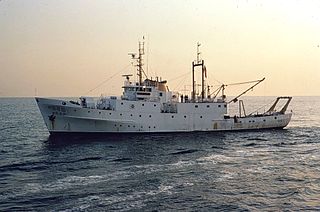
NOAA Ship Albatross IV, originally BCF Albatross IV, was a fisheries research ship in commission in the United States Fish and Wildlife Service's Bureau of Commercial Fisheries from 1963 to 1970 and in the National Oceanic and Atmospheric Administration (NOAA) from 1970 to 2008.

NOAA Ship John N. Cobb was a National Oceanic and Atmospheric Administration research vessel in commission from 1970 to 2008. She was named for John Nathan Cobb and was the oldest commissioned ship in the NOAA fleet when she was decommissioned, having previously served in the United States Department of the Interior′s Fish and Wildlife Service from 1950 to 1956 and in the United States Fish and Wildlife Service′s Bureau of Commercial Fisheries from 1956 to 1970 as US FWS John N. Cobb.
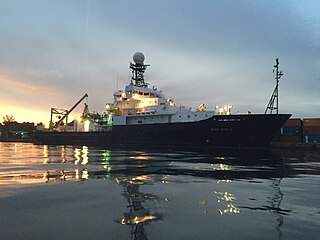
R/V Roger Revelle is a Thomas G. Thompson-class oceanographic research ship operated by Scripps Institution of Oceanography under charter agreement with Office of Naval Research as part of the University-National Oceanographic Laboratory System (UNOLS) fleet. The ship is named after Roger Randall Dougan Revelle, who was essential to the incorporation of Scripps into the University of California San Diego.

USNS Adventurous (T-AGOS-13) was a Stalwart-class modified tactical auxiliary general ocean surveillance ship of the United States Navy in service from 1988 to 1992. She was in non-commissioned service in the Military Sealift Command from 1988 to 1992, operating during the final years of the Cold War. She was transferred to the National Oceanic and Atmospheric Administration (NOAA) in 1992 and in 2003 was commissioned into service with NOAA as the fisheries research ship NOAAS Oscar Elton Sette.

USNS Relentless (T-AGOS-18) was a Stalwart-class modified tactical auxiliary general ocean surveillance ship in service in the United States Navy from 1990 to 1993. Since 1998, she has been in commission in the National Oceanic and Atmospheric Administration (NOAA) fleet as the fisheries research ship NOAAS Gordon Gunter.
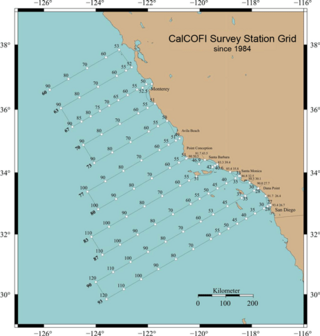
CalCOFI is a multi-agency partnership formed in 1949 to investigate the collapse of the sardine population off California. The organization's members are from NOAA Fisheries Service, Scripps Institution of Oceanography, and California Department of Fish and Wildlife. The scope of this research has evolved into the study of marine ecosystems off California and the management of its fisheries resources. In 2004, the CalCOFI survey area became one of 26 LTER research sites. This time-series of oceanographic and fisheries data allows scientists to assess the human impact and effects of climate change on the coastal ocean ecosystem. CalCOFI hydrographic & biological data, publications, and web information are distributed for use without restriction under the terms of the GNU Free Documentation License.
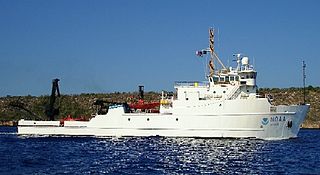
The NOAA Ship Nancy Foster is a National Oceanic and Atmospheric Administration research vessel. The ship is named for Dr. Nancy Foster, who was the director of the National Marine Fisheries Service’s Office of Protected Resources from 1986 until 1993, and the director of the National Ocean Service from 1997 until her death in 2000.
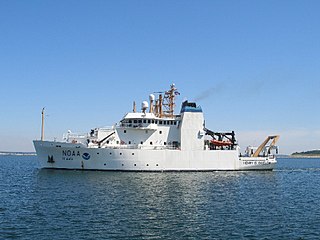
NOAAS Henry B. Bigelow is a fisheries research vessel operated by the United States' National Oceanic Atmospheric Administration (NOAA). She is the second in a class of five new fisheries research vessels. She is named after Henry Bryant Bigelow (1879-1967), the American oceanographer, zoologist, and marine biologist who founded the Woods Hole Oceanographic Institution in Woods Hole, Massachusetts.

NOAAS Reuben Lasker is a National Oceanic and Atmospheric Administration (NOAA) fishery research vessel. The ship's namesake, Reuben Lasker, was a fisheries biologist who served with the Southwest Fisheries Center, National Marine Fisheries Service, and taught at the Scripps Institution of Oceanography. This class of NOAA ships is very similar to, and based in part upon, the Neil Armstrong-class Oceanographic Research (AGOR) ships owned by the Office of Naval Research and operated by various US Universities.

USFC Fish Hawk was a fisheries science research ship operated by the United States Commission of Fish and Fisheries, commonly called the United States Fish Commission, from 1880 to 1903 and as USFS Fish Hawk by its successor, the United States Bureau of Fisheries, from 1903 1918 and from 1919 to 1926. She was the first large ship purpose-built by any country for the promotion of fisheries, and spent her 46-year career operating along the United States East Coast, in the Gulf of Mexico, and off Puerto Rico.

US FWS Albatross III was a fisheries research ship in commission in the United States Fish and Wildlife Service from 1948 to 1959. Prior to her Fish and Wildlife Service career, she operated as the commercial fishing trawler SS Harvard and briefly saw service during World War II as the United States Coast Guard patrol vessel USCGC Bellefonte (WYP-373), in commission from April to August 1944. She was wrecked in Cuba as Nyleve in 1969.

NOAAS Oregon II is an American fisheries research vessel in commission in the National Oceanic and Atmospheric Administration (NOAA) fleet since 1977. Prior to her NOAA career, she was delivered to the United States Fish and Wildlife Service's Bureau of Commercial Fisheries in 1967 and was transferred to NOAA in 1970, but was not placed in commission until 1977.
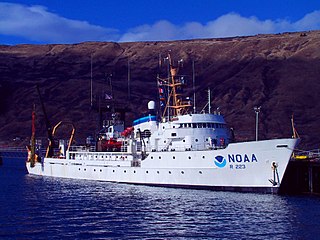
NOAAS Miller Freeman was an American fisheries and oceanographic research vessel that was in commission in the National Oceanic and Atmospheric Administration (NOAA) fleet from 1975 to 2013. Prior to her NOAA career, she was in commission in the United States Fish and Wildlife Service's Bureau of Commercial Fisheries from 1967 to 1970 as US FWS Miller Freeman.

NOAAS Townsend Cromwell was an American fisheries research vessel that was in commission in the National Oceanic and Atmospheric Administration (NOAA) fleet from 1975 to 2002. Prior to her NOAA career, she was in the United States Fish and Wildlife Service's Bureau of Commercial Fisheries fleet from 1963 to 1975 as US FWS Townsend Cromwell.

NOAAS Chapman was an American fisheries research vessel that was in commission in the National Oceanic and Atmospheric Administration (NOAA) fleet from 1980 to 1998. After the conclusion of her NOAA career, she spent several years operating as the University of Puerto Rico marine research vessel R/V Chapman. More recently, she has become the Curaçao-based mothership for the deep-diving submarine Curasub.

R/V Ocean Starr is an American research vessel. She was in the United States Fish and Wildlife Service's Bureau of Commercial Fisheries fleet from 1966 to 1970 as US FWS David Starr Jordan. The ship later served under the National Oceanic and Atmospheric Administration (NOAA) from 1970 to 2010.
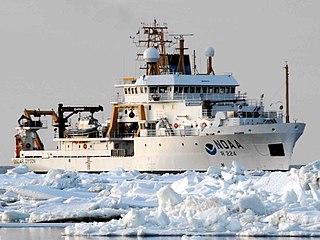
NOAAS Oscar Dyson is an American fisheries and oceanographic research vessel in commission in the National Oceanic and Atmospheric Administration (NOAA) fleet since 2005.

NOAAS Pisces is an American fisheries and oceanographic research vessel in commission in the National Oceanic and Atmospheric Administration (NOAA) fleet since 2009.

RV Corella (LT767) was a fisheries research vessel that was operated by the Ministry of Agriculture, Fisheries and Food - Directorate of Fisheries, now known as the Centre for Environment, Fisheries and Aquaculture Science (Cefas) between 1967 and 1983.




















